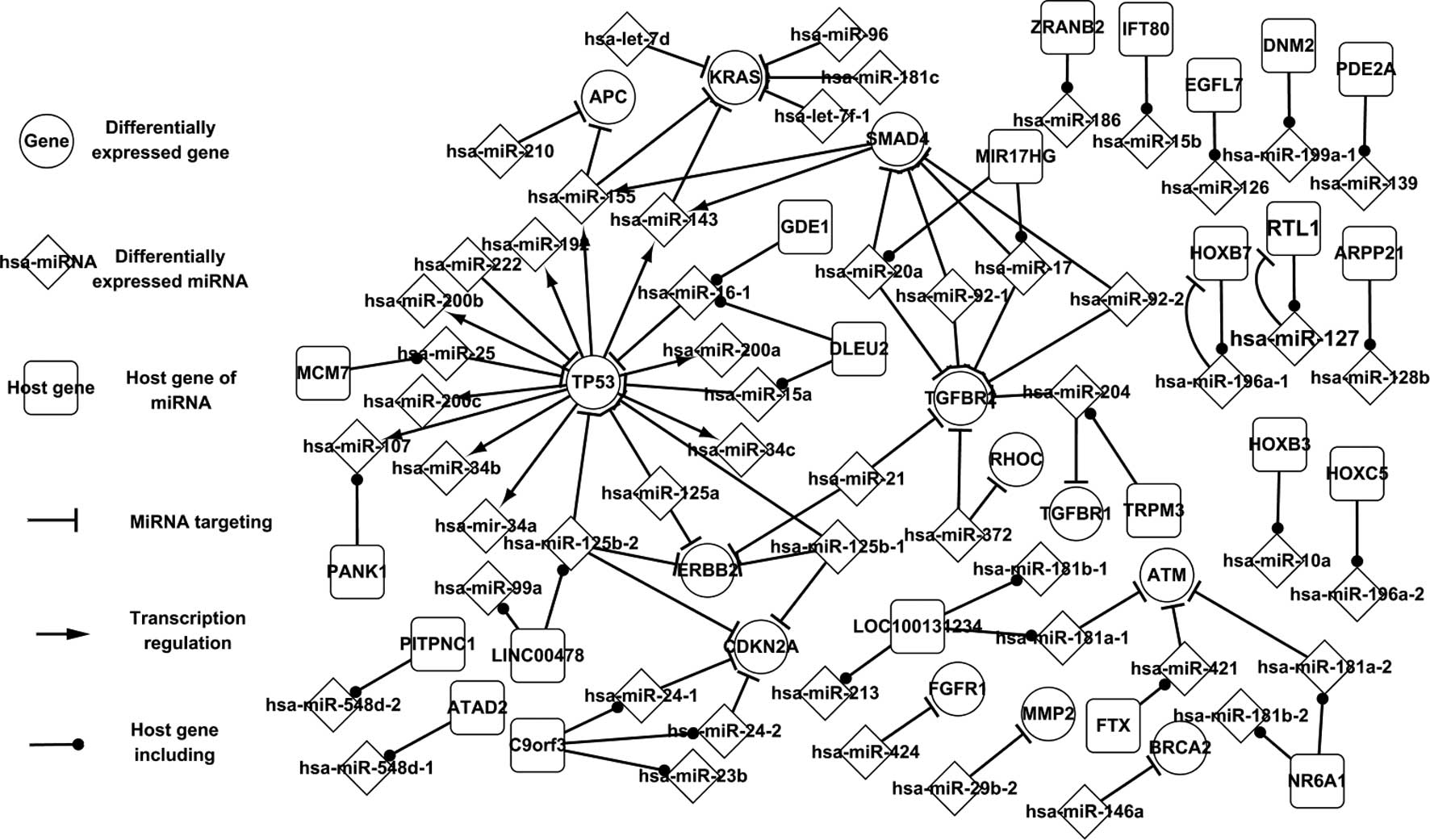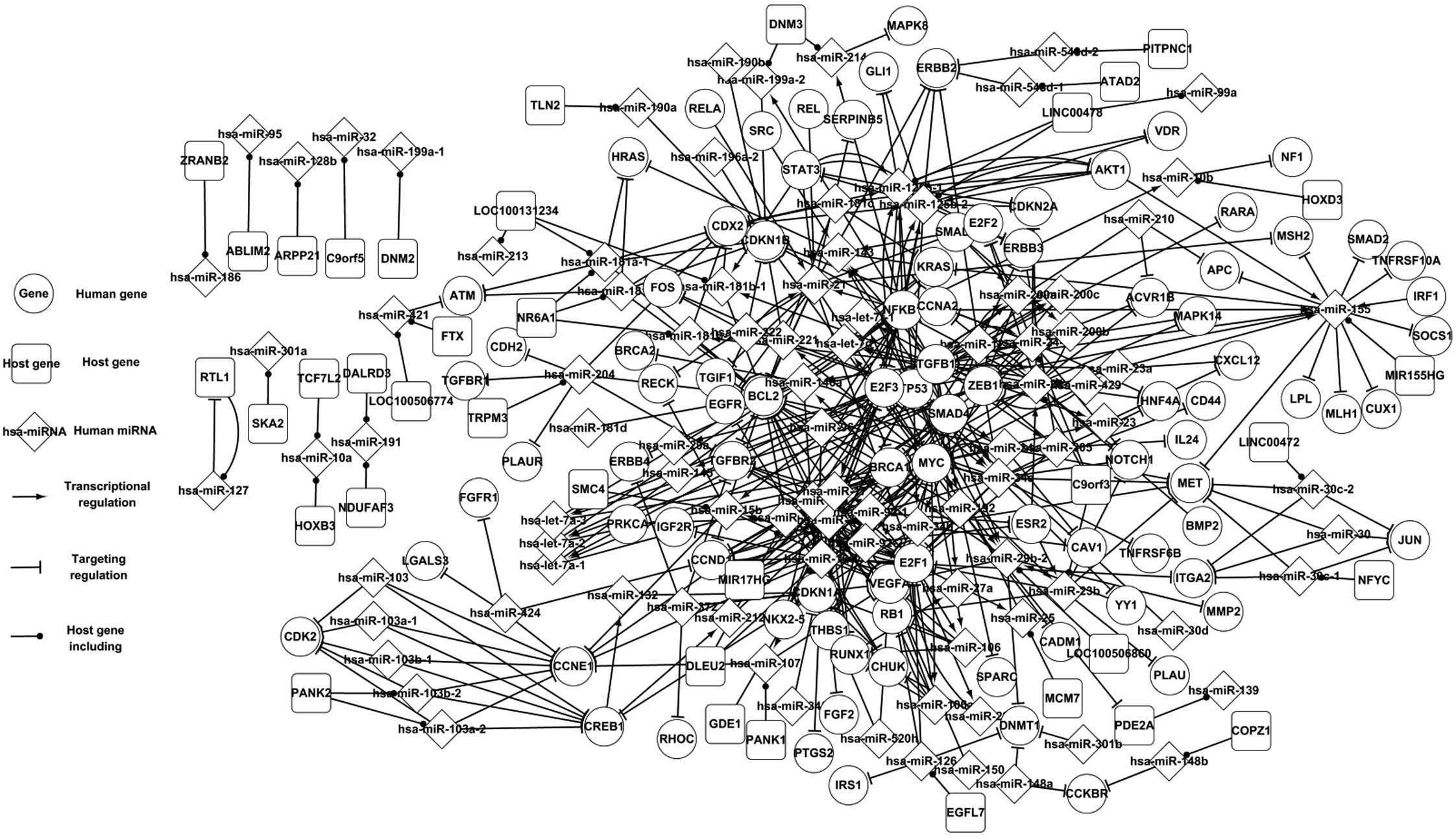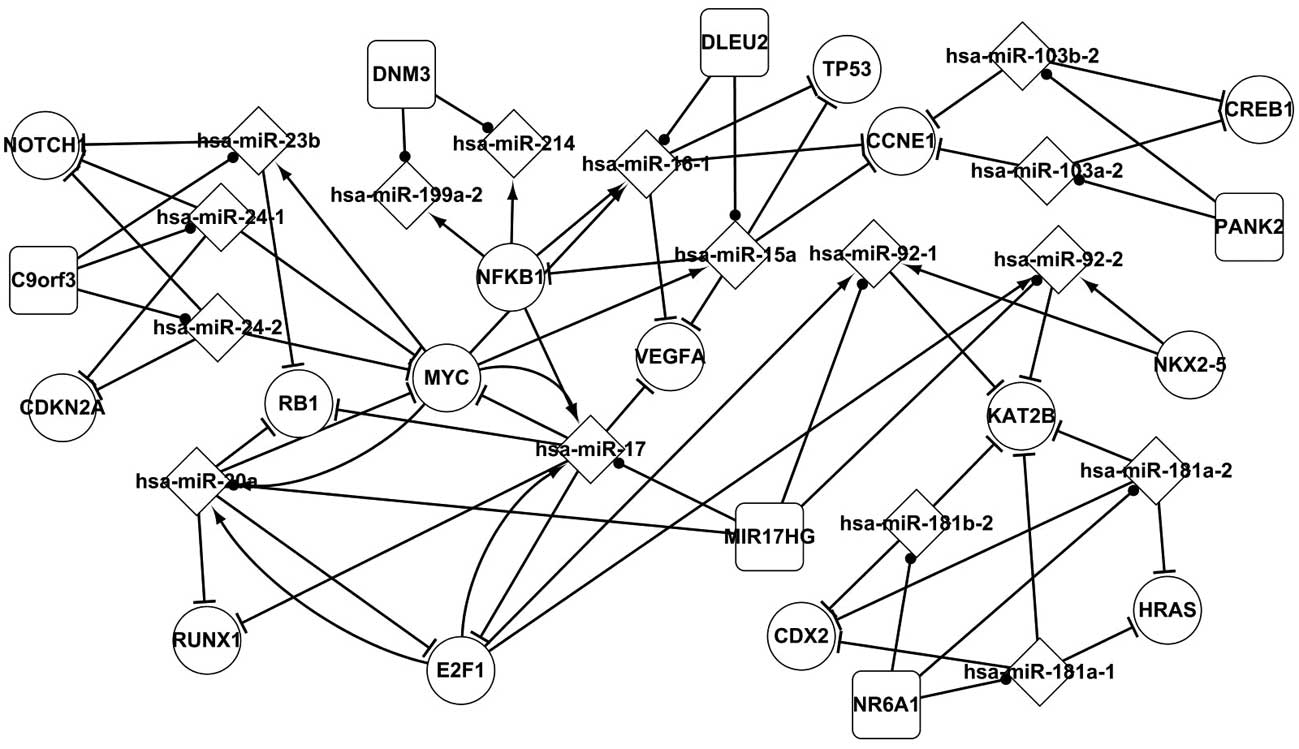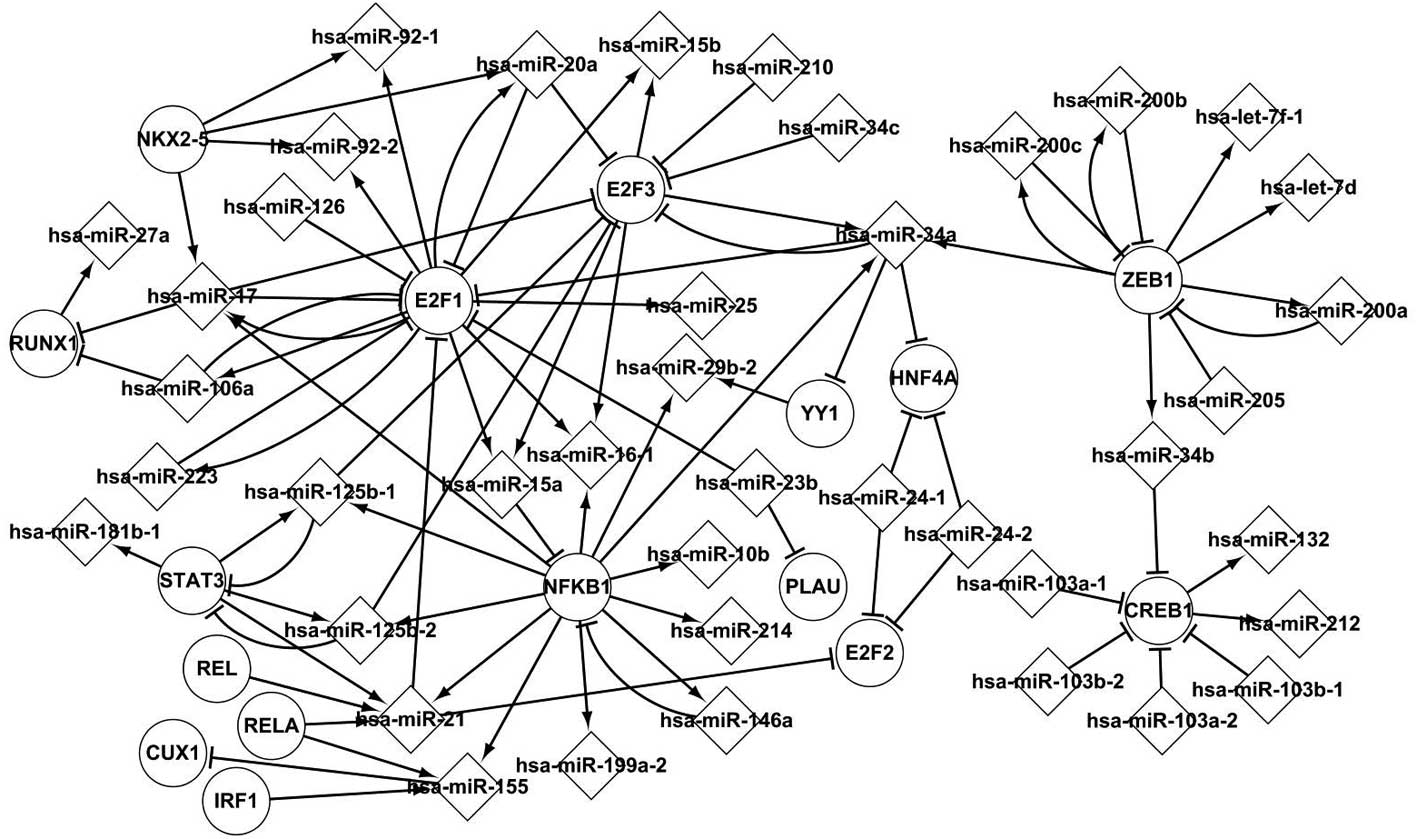Introduction
Pancreatic cancer (PC) is the fourth primary cause
of cancer-related mortality and <5% of patients survive for five
years following the diagnosis, with a median survival time of 4–6
months (1).
Transcription factors (TFs) and microRNAs (miRNAs)
are prominent regulators for gene expression (2). TFs are proteins that are able to
activate or repress transcription by binding to
cis-regulatory elements that are located in the upstream
regions of genes. miRNAs are small (21–24 nt) non-coding RNA
molecules that control key cellular processes, including
proliferation, differentiation and apoptosis. Zhang et al
demonstrated that miRNAs were identified to play fundamentally
important roles in PC (3). The
study illustrated the biogenesis and differential expression of
miRNAs and their corresponding potential roles in the pathogenesis,
progression and metastasis of PC.
Several transcription profiling studies involving
miRNA transfection experiments have shown that miRNAs exert a
widespread impact on the regulation of their target genes (targets)
(4). To date, numerous databases
supply abundant resources to study the association between miRNAs
and their targets.
Host genes are those genes to which the miRNAs
locate. Rodriguez et al indicated that miRNAs are
transcribed in parallel with their host transcripts and identified
two transcription classes of miRNAs, exonic and intronic (5). Baskerville et al identified
that intronic miRNAs are closely associated with their host genes
(6).
Numerous differentially-expressed genes and miRNAs
have been identified through a large quantity of PC experiments
(7). However, the experiments are
mostly based on a single element (gene or miRNA), which makes it
difficult to analyze the general pathogenesis of PC. The present
study focused on the underlying network of miRNAs, the targets of
the miRNAs, the TFs and the host genes of the miRNAs in order to
aid in the identification of the key pathway control mechanisms of
PC.
Materials and methods
Material collection and data
processing
The experimentally validated dataset of human miRNAs
and their targets were extracted from Tarbase 5.0 (8) and miRTarBase (9) and were considered as set
A1.
The experimentally validated dataset of human TFs
and the miRNAs that were regulated by them were extracted from
TransmiR (10) and were considered
as set A2.
The host genes of the human miRNAs were extracted
from miRBase (11) and the National
Centre for Biotechnology Information (NCBI). Official symbols and
IDs were used to signify each host gene. This data set was
considered as A3.
The differentially-expressed genes were collected
from the Kyoto Encyclopedia of Genes and Genomes (KEGG) pathway
database (12), the Cancer Genetics
Web (http://www.cancerindex.org/geneweb/index.htm), the
NCBI SNP database (http://www.ncbi.nlm.nih.gov/snp/) and from the
relevant literature. The PC-related genes were collected from the
GeneCards database (13) and
relevant literature, and included the genes that affect tumor
growth, migration, radial therapy and the clinical outcome of
patients with PC. Additionally, 22 popular TFs were extracted using
the P-match method (14) and were
considered as PC-related genes. The present study only focused on
the TFs that appeared in transmiR. Promoter region sequences of
1,000 nt in length that are targeted by differentially-expressed
miRNAs were downloaded from the University of California Santa Cruz
(UCSC) database (15). The P-match
method, which combines pattern matching and weight matrix
approaches, was used to identify the TF-binding sites (TFBSs) in
the 1,000-nt promoter region sequences, which were mapped onto the
promoter region of the targets. The matrix library of P-match
contains sets of known TFBSs that have been collected in TRANSFAC,
allowing the possibility of searching for a large variety of TFBSs.
The vertebrate matrix was used with a restricted high quality
criterion, which was considered as set
A4.
Differentially-expressed miRNAs were collected from
mir2Disease (16) and the relevant
literature was examined to extract PC-related miRNAs. This dataset
was considered as set A5.
Network construction
The following method was used to construct the
differentially-expressed, related and global networks. All the
regulatory factors for the TFs, miRNAs, targets and host genes were
extracted from datasets A1,
A2 and A3. The
global network was obtained as a result of combining the regulatory
factors. The differentially-expressed elements were separately
extracted from datasets A4 and
A5, and the factors with
differentially-expressed elements were selected from the global
network, thus forming the differentially-expressed network. A
similar method was used to construct the related network.
Results
Differentially-expressed PC network
Fig. 1 shows the
significant regulatory factors of the differentially-expressed
elements in PC. This network is composed of three TFs (TP53, SMAD4
and CDKN2A), targets of miRNAs, miRNAs and host genes. The nodes
are all differentially expressed with the exception of the host
genes. The three TF-related pathways are the most significant among
them. hsa-miR-17 targets SMAD4, which regulates hsa-miR-143 and
hsa-miR-155. Navarro et al(17) revealed that TP53 regulates
hsa-miR-143. Xu et al(18)
identified that hsa-miR-143 targets KRAS. TP53 has been suggested
to indirectly affect KRAS by hsa-miR-143. Zhang et
al(19) indicated that
hsa-miR-155 targets APC. Therefore, it was concluded that SMAD4 was
able to indirectly affect APC by hsa-miR-155. TP53 directly
regulates hsa-miR-125b and in turn, hsa-miR-125b targets TP53
(20), suggesting a self-adaptation
association between the two. Certain miRNA pathways and the
corresponding host genes are highlighted in the present study. RTL1
and hsa-miR-127, and HOXB7 and hsa-miR-196a-1 form self-adaptation
associations. A host gene may include several miRNAs. C9orf3
contains hsa-miR-24 and hsa-miR-23b. Furthermore, an miRNA may be
located in several genes. hsa-miR-548d is present in ATAD2 and
PITPNC1. The combined action of the nodes in the
differentially-expressed network partially revealed the regulatory
mechanism of PC.
Related PC network
Fig. 2 shows the
numerous regulatory associations in PC with regard to genes and
miRNAs. The related network incorporates the
differentially-expressed network. Fig.
2 shows three differentially-expressed TFs and 23 additional
TFs. With the exception of the differentially-expressed miRNAs,
seven related miRNAs (hsa-miR-145, hsa-miR-29a, hsa-miR-30d,
hsa-let-7a-1, hsa-let-7a-2, hsa-let-7a-3 and hsa-let-7i) are shown.
Fig. 2 also depicts additional gene
and miRNA pathways. MYC and ZEB1 regulate hsa-let-7d, which targets
KRAS. AKT1, NFKB1, STAT3 and CDX2 regulate hsa-miR-125b, which in
turn regulates TP53, AKT1 and STAT3. Qiu et al(21) elucidated that the activation of the
STAT3 signaling pathway plays a significant role in the progression
of PC. The related network expands the additional topological
associations of the differentially-expressed elements and
contributes to a further understanding of the pathogenesis of
PC.
Global PC network
The global network involves more comprehensive
regulatory associations, including A1,
A2 and A3, and is
an experimentally validated biological network in the human body.
The network incorporates the differentially-expressed and related
networks.
Host genes and miRNAs in PC
Fig. 3 shows certain
significant characteristics of the host genes and their miRNAs.
Although the host genes themselves are not differentially expressed
in PC, they are considered to be so since their miRNAs are
differentially expressed. DLEU2 contains hsa-miR-15a and
hsa-miR-16-1, which are regulated by MYC and together target VEGFA,
TP53 and CCNE1. MIR17HG is a host gene for hsa-miR-92-1,
hsa-miR-92-2, hsa-miR-17 and hsa-miR-20a, which are regulated by
E2F1. hsa-miR-17 and hsa-miR-20a separately form self-adaptation
associations with MYC and E2F1. PANK2 includes hsa-miR-103a-2 and
hsa-miR-103b-2, which target CCNE1 and CREB1.
Transcriptional network of popular
TFs
A further 41 differentially-expressed miRNAs that
are regulated by popular TFs were analyzed. Fig. 4 shows the regulatory interactions
between these popular TFs and the differentially-expressed miRNAs,
in addition to the targets in PC. The TFs and miRNAs affect their
successors in the transcriptional network. A total of four TFs,
NFKB1, ZEB1, E2F1 and E2F3, have been experimentally validated in
PC. Fig. 4 shows the TFs, ZEB1,
E2F3 and NFKB1, which coregulate hsa-miR-34a, which in turn targets
E2F3, YY1, HNF4A and E2F1. Fig. 4
also shows that one differentially-expressed miRNA may be regulated
by several TFs, that a target is targeted by several
differentially-expressed miRNAs and that a TF indirectly affects
other genes by several differentially-expressed miRNAs.
hsa-miR-16-1 is regulated by E2F1, E2F3 and NFKB1. RUNX1 is
targeted by hsa-miR-17 and hsa-miR-106a. ZEB1 indirectly regulates
CREB1 by hsa-miR-34b, and hsa-miR-125b indirectly affects
hsa-miR-21 by STAT3. The transcriptional network of popular TFs and
miRNAs may aid in the analysis of the pathogenesis of PC.
Regulatory pathway of
differentially-expressed genes
The upstream and downstream information of the
differentially-expressed genes and miRNAs and the popular TFs was
extracted in order to describe the PC network more clearly.
The successor and precursor nodes of the
differentially-expressed genes in the three networks were extracted
to compare and analyze the regulatory pathway. Among these genes,
TP53 and SMAD4 were observed to exhibit a characteristic that was
common to the precursor and successor nodes, indicating that the
gene and miRNA form a self-adaptation association.
Using TP53 as an example, Table I shows TP53 and the predecessors and
successors of the gene, in addition to their regulatory
associations. TP53 is a notable tumor suppressor and is
significantly featured in the three networks. Table I shows eight miRNAs that target
TP53, which itself regulates 12 miRNAs in the
differentially-expressed network. Therefore, the eight miRNAs
indirectly affect the expression of the 12 miRNAs through TP53.
hsa-miR-125b and TP53 were observed to regulate each other in the
three networks, indicating that they are crucial in the progression
of PC. A mutation in the TP53 gene is implicated in the
pathogenesis of PC through the constitutive activation of the p53
pathway.
 | Table IRegulatory association between miRNAs
and TP53. |
Table I
Regulatory association between miRNAs
and TP53.
| miRNAs that target
TP53 | | miRNAs that are
regulated by TP53 |
|---|
| |
|
|---|
|
Differentially-expressed network | Related network | Global network | Gene symbol |
Differentially-expressed network | Related network | Global network |
|---|
| miR-125a | miR-125a | miR-125a | TP53 | miR-107 | miR-107 | miR-107 |
| miR-125b-1 | miR-125b-1 | miR-125b-1 | | miR-125b-1 | miR-125b-1 | miR-125b-1 |
| miR-125b-2 | miR-125b-2 | miR-125b-2 | | miR-125b-2 | miR-125b-2 | miR-125b-2 |
| miR-15a | miR-15a | miR-15a | | miR-143 | miR-143 | miR-143 |
| miR-16-1 | miR-16-1 | miR-16-1 | | miR-155 | miR-155 | miR-155 |
| miR-221 | miR-221 | miR-221 | | miR-192 | miR-192 | miR-192 |
| miR-222 | miR-222 | miR-222 | | miR-200a | miR-200a | miR-200a |
| miR-25 | miR-25 | miR-25 | | miR-200b | miR-200b | miR-200b |
| miR-30d | miR-30d | | miR-200c | miR-200c | miR-200c |
| | miR-612 | | miR-34a | miR-34a | miR-34a |
| | | | miR-34b | miR-34b | miR-34b |
| | | | miR-34c | miR-34c | miR-34c |
| | | | | miR-145 | miR-145 |
| | | | | miR-29a | miR-29a |
| | | | | | miR-215 |
| | | | | | miR-29b-1 |
| | | | | | miR-29b-2 |
| | | | | | miR-29c |
| | | | | | miR-194-1 |
| | | | | | miR-194-2 |
| | | | | | miR-519d |
Regulatory pathway of
differentially-expressed miRNAs
Similar to the differentially-expressed genes, the
differentially-expressed miRNA pathways were extracted, compared
and analyzed using the same method. Among these miRNAs, 13
differentially-expressed miRNAs (hsa-miR-146a, hsa-miR-34a,
hsa-miR-125b-1, hsa-miR-125b-2, hsa-miR-17-5p, hsa-miR-200a,
hsa-miR-200b, hsa-miR-200c, hsa-miR-20a, hsa-miR-21, hsa-miR-223,
hsa-miR-24-1 and hsa-miR-429) and their corresponding genes were
observed to form self-adaptation associations.
Using hsa-miR-125b as an example, Table II presents hsa-miR-125b and the
predecessors and successors of the miRNA, in addition to the
regulatory associations between them. Table II indicates that TP53 regulates
hsa-miR-125b that target TP53, CDKN2A and ERBB2 in the
differentially expressed network. Certain targets of the global
network have been omitted. Table
II also shows that AKT1 and hsa-miR-125b, and STAT3 and
hsa-miR-125b separately form self-adaptation associations.
hsa-miR-125b also indirectly affects other miRNAs by certain TFs.
hsa-miR-125b targets TP53, which regulates hsa-miR-143 and
hsa-miR-155. Certain miRNAs also indirectly affect hsa-miR-125b
through TFs. hsa-miR-15a targets NFKB1, which regulates
hsa-miR-125b.
 | Table IIRegulatory associations between
hsa-miR-125b and genes. |
Table II
Regulatory associations between
hsa-miR-125b and genes.
| Genes that regulate
hsa-miR-125b | | Genes that are
targeted by hsa-miR-125b |
|---|
| |
|
|---|
|
Differentially-expressed network | Related
network | Global network | miRNA symbol |
Differentially-expressed network | Related
network | Global network |
|---|
| TP53 | TP53 | TP53 | miR-125b | TP53 | TP53 | TP53 |
| AKT1 | AKT1 | | CDKN2A | CDKN2A | CDKN2A |
| NFKB1 | NFKB1 | | ERBB2 | ERBB2 | ERBB2 |
| STAT3 | STAT3 | | | AKT1 | AKT1 |
| CDX2 | CDX2 | | | STAT3 | STAT3 |
| | | | | BBC3 | BBC3 |
| | | | | E2F3 | E2F3 |
| | | | | ERBB3 | ERBB3 |
| | | | | GLI1 | GLI1 |
| | | | | IGF2 | IGF2 |
| | | | | VDR | VDR |
| | | | | | ABCC4 |
| | | | | | ATXN1 |
| | | | | | BMF |
Regulatory pathway of popular TFs
The same method was used to extract, compare and
analyze the pathways of each popular TF in the related network. A
total of five TFs, E2F1, E2F3, NFKB1, STAT3 and ZEB1, which are
associated with PC, and their corresponding miRNAs were observed to
form self-adaptation associations.
Using E2F1 as an example, Table III shows that four
differentially-expressed miRNAs, hsa-miR-106a, hsa-miR-17,
hsa-miR-20a and hsa-miR-223, separately form self-adaptation
associations with E2F1. E2F1 is not differentially expressed in PC,
but the four miRNAs are differentially expressed. Therefore, the
four miRNAs may indirectly lead to the aberrant expression of other
miRNAs by E2F1. The E2F1 and differentially-expressed miRNA
pathways indicated an additional 14 significant
differentially-expressed miRNAs in PC. These miRNAs are not only
differentially expressed, but are also adjacent nodes of E2F1 that
are frequently involved in the transcription of cancer.
 | Table IIIRegulatory associations between
miRNAs and E2F1. |
Table III
Regulatory associations between
miRNAs and E2F1.
| miRNAs that target
E2F1 | | miRNAs that are
regulated by E2F1 |
|---|
| |
|
|---|
|
Differentially-expressed network | Related
network | Global network | Gene symbol |
Differentially-expressed network | Related
network | Global network |
|---|
| miR-106a | miR-106a | miR-106a | E2F1 | miR-106a | miR-106a | miR-106a |
| miR-126 | miR-126 | miR-126 | | miR-15a | miR-15a | miR-15a |
| miR-17 | miR-17 | miR-17 | | miR-15b | miR-15b | miR-15b |
| miR-20a | miR-20a | miR-20a | | miR-16-1 | miR-16-1 | miR-16-1 |
| miR-21 | miR-21 | miR-21 | | miR-17 | miR-17 | miR-17 |
| miR-223 | miR-223 | miR-223 | | miR-20a | miR-20a | miR-20a |
| miR-23b | miR-23b | miR-23b | | miR-223 | miR-223 | miR-223 |
| miR-34a | miR-23b | miR-34a | | miR-25 | miR-25 | miR-25 |
| miR-23b | let-7a-1 | | miR-92-1 | miR-92-1 | miR-92-1 |
| let-7a-1 | let-7a-2 | | miR-92-2 | miR-92-2 | miR-92-2 |
| let-7a-2 | let-7a-3 | | | let-7i | miR-92-2 |
| let-7a-3 | miR-149 | | | | let-7i |
| | miR-106b | | | | let-7a-1 |
| | miR-330 | | | | let-7a-2 |
| | miR-93 | | | | let-7a-3 |
| | miR-98 | | | | miR-195 |
| | | | | | miR-19a |
| | | | | | miR-106b |
| | | | | | miR-16-2 |
| | | | | | miR-18a |
| | | | | | miR-18b |
| | | | | | miR-19b-1 |
| | | | | | miR-19b-2 |
| | | | | | miR-20b |
| | | | | | miR-363 |
| | | | | | miR-449a |
| | | | | | miR-449b |
| | | | | | miR-449c |
| | | | | | miR-93 |
Discussion
The present study derived three regulatory networks,
differentially-expressed, related and global, by analyzing the
current experimentally validated genes and miRNAs that are
associated with PC. The results revealed certain significant
pathways in PC and identified a topological network of the
development of PC. Certain pathways possessed specific features; 13
differentially-expressed miRNAs and corresponding genes were shown
to form self-adaptation associations. Self-adaptation associations
were also identified in five popular TFs and 11
differentially-expressed miRNAs. A further 41 significant
differentially-expressed miRNAs were obtained by comparing the
differentially-expressed and popular transcription networks.
hsa-miR-127 and its host gene, RTL1, and hsa-miR-196a-1 and its
host gene, HOXB7, were observed to separately form self-adaptation
associations. Certain pathways have not only been found in PC, but
also in other carcinomas. For example, TP53 drives invasion in
breast tumors through the upregulation of hsa-miR-155. TFBSs were
identified by combining pattern matching and weight matrix
approaches in the 1,000-nt promoter region sequences, and were then
mapped onto the promoter region of the targets. The TFs predicted
from this method suggest the potential correlations between the
differentially expressed miRNAs and TFs. More attention should be
paid to them and experiments should be conducted to validate the
close correlations with PC. The present study partially uncovered
the regulatory associations in the development of PC and supplied
comprehensive data associated with PC. Certain key pathways may aid
studies to further investigate the carcinogenicity mechanism and
therapy of PC. In future studies, the interaction of proteins and
regulatory patterns, including upregulation and downregulation,
will be taken into account and a more comprehensive and extensive
network of PC will be constructed. As a consequence of these
studies, the prognosis, diagnosis and therapy of PC may be
improved.
Acknowledgements
This study was supported by grants from the National
Natural Science Foundation of China (grant no. 60973091 and
60905022) and the Natural Science Foundation of Jilin Province
(grant no. 20130101166JC).
Abbreviations:
|
miRNA
|
microRNA
|
|
TFs
|
transcription factors
|
|
targets
|
target genes
|
|
PC
|
pancreatic cancer
|
|
NCBI
|
National Center for Biotechnology
Information
|
|
TFBSs
|
transcription factor binding sites
|
References
|
1
|
Jemal A, Tiwari RC, Murray T, Ghafoor A,
Samuels A, Ward E, Feuer EJ and Thun MJ; American Cancer Society.
Cancer statistics, 2004. CA Cancer J Clin. 54:8–29. 2004.
View Article : Google Scholar
|
|
2
|
Hobert O: Gene regulation by transcription
factors and microRNAs. Science. 319:1785–1786. 2008. View Article : Google Scholar : PubMed/NCBI
|
|
3
|
Zhang L, Jamaluddin MS, Weakley SM, Yao Q
and Chen C: Roles and mechanisms of microRNAs in pancreatic cancer.
World J Surg. 35:1725–1731. 2011. View Article : Google Scholar : PubMed/NCBI
|
|
4
|
Naeem H, Küffner R and Zimmer R: MIRTFnet:
analysis of miRNA regulated transcription factors. PLoS One.
6:e225192011. View Article : Google Scholar : PubMed/NCBI
|
|
5
|
Rodriguez A, Griffiths-Jones S, Ashurst JL
and Bradley A: Identification of mammalian microRNA host genes and
transcription units. Genome Res. 14:1902–1910. 2004. View Article : Google Scholar : PubMed/NCBI
|
|
6
|
Baskerville S and Bartel DP: Microarray
profiling of microRNAs reveals frequent coexpression with
neighboring miRNAs and host genes. RNA. 11:241–247. 2005.
View Article : Google Scholar : PubMed/NCBI
|
|
7
|
Pavlakis E, Papaconstantinou I, Gazouli M,
et al: MicroRNA gene polymorphisms in pancreatic cancer.
Pancreatology. 13:273–278. 2013. View Article : Google Scholar : PubMed/NCBI
|
|
8
|
Papadopoulos GL, Reczko M, Simossis VA,
Sethupathy P and Hatzigeorgiou AG: The database of experimentally
supported targets: a functional update of TarBase. Nucleic Acids
Res. 37:D155–D158. 2009. View Article : Google Scholar : PubMed/NCBI
|
|
9
|
Hsu SD, Lin FM, Wu WY, et al: miRTarBase:
a database curates experimentally validated microRNA-target
interactions. Nucleic Acids Res. 39:D163–D169. 2011. View Article : Google Scholar : PubMed/NCBI
|
|
10
|
Wang J, Lu M, Qiu C and Cui Q: TransmiR: a
transcription factor-microRNA regulation database. Nucleic Acids
Res. 38:D119–D122. 2010. View Article : Google Scholar : PubMed/NCBI
|
|
11
|
Kozomara A and Griffiths-Jones S: miRBase:
integrating microRNA annotation and deep-sequencing data. Nucleic
Acids Res. 39:D152–D157. 2011. View Article : Google Scholar : PubMed/NCBI
|
|
12
|
Kanehisa M and Goto S: KEGG: kyoto
encyclopedia of genes and genomes. Nucleic Acids Res. 28:27–30.
2000. View Article : Google Scholar : PubMed/NCBI
|
|
13
|
Safran M, Dalah I, Alexander J, et al:
GeneCards Version 3: the human gene integrator. Database (Oxford).
5:20102010.
|
|
14
|
Chekmenev DS, Haid C and Kel AE: P-Match:
transcription factor binding site search by combining patterns and
weight matrices. Nucleic Acids Res. 33:W432–W437. 2005. View Article : Google Scholar : PubMed/NCBI
|
|
15
|
Fujita PA, Rhead B, Zweig AS, et al: The
UCSC Genome Browser database: update 2011. Nucleic Acids Res.
39:D876–D882. 2011. View Article : Google Scholar : PubMed/NCBI
|
|
16
|
Jiang Q, Wang Y, Hao Y, et al:
miR2Disease: a manually curated database for microRNA deregulation
in human disease. Nucleic Acids Res. 37:D98–D104. 2009. View Article : Google Scholar : PubMed/NCBI
|
|
17
|
Navarro A, Diaz T, Gallardo E, et al:
Prognostic implications of miR-16 expression levels in resected
non-small-cell lung cancer. J Surg Oncol. 103:411–415. 2011.
View Article : Google Scholar : PubMed/NCBI
|
|
18
|
Xu B, Niu X, Zhang X, et al: miR-143
decreases prostate cancer cells proliferation and migration and
enhances their sensitivity to docetaxel through suppression of
KRAS. Mol Cell Biochem. 350:207–213. 2011. View Article : Google Scholar : PubMed/NCBI
|
|
19
|
Zhang Y, Wei W, Cheng N, et al: Hepatitis
C virus-induced up-regulation of microRNA-155 promotes
hepatocarcinogenesis by activating Wnt signaling. Hepatology.
56:1631–1640. 2012. View Article : Google Scholar : PubMed/NCBI
|
|
20
|
Kumar M, Lu Z, Takwi AA, et al: Negative
regulation of the tumor suppressor p53 gene by microRNAs. Oncogene.
30:843–853. 2011. View Article : Google Scholar : PubMed/NCBI
|
|
21
|
Qiu Z, Huang C, Sun J, et al: RNA
interference-mediated signal transducers and activators of
transcription 3 gene silencing inhibits invasion and metastasis of
human pancreatic cancer cells. Cancer Sci. 98:1099–1106. 2007.
View Article : Google Scholar : PubMed/NCBI
|


















